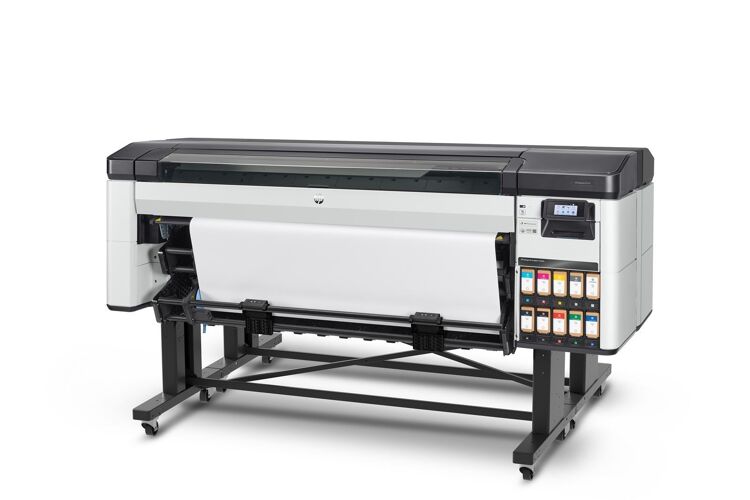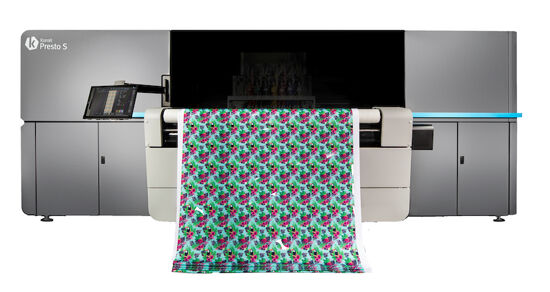The benefits of large format printing for photographers

Nessan Cleary discusses how almost all current large format machines can print good quality images but the photography market has quite distinct needs. Nessan shares the advantages of large format printing for photographers.
The photography market was one of the first applications to fully embrace large format printing, helped by the fact that from the beginning the development of digital cameras ran in parallel with the advances in large format inkjet printing. Many of the early players, including Scitex and Kodak, also sold digital cameras so there was an obvious synergy.
Large format printing offers distinct advantages to photographers in that it’s relatively easy to set up a printer, and to make multiple identical copies on a variety of different substrates and in a range of sizes, all things that are not so straightforward in a darkroom. For these reasons, even those photographers that still prefer to work on film, will often use a scanner to digitise and output their images.
However, the photographic market also has some distinct requirements that set it apart from other applications. The most obvious of these is the need to reproduce high resolution images complete with a wide colour gamut that can match the expectations created from seeing the output from modern digital cameras on a screen. Those cameras have become increasingly sophisticated, partly because of the need to keep up with 4K and 8K video production. This means that many cameras, even down to the consumer level, can now produce 40 to 60MB images and there are also several medium format cameras that offer even higher resolution.
For this reason, the photography market is still dominated by devices using water-based pigment inks, which allow for high printing resolutions. Several vendors cater for this market with inksets up to 12 colours that are capable of reproducing the widest colour gamut. These inksets include light colours, sometimes referred to as photo colours in this market, for better gradation. But they also include other colours, such as red and blue to ensure they can reproduce vibrant reds, oranges and purples as well as blue gradients in skies, plus skin tones and subtle tones in shadows.
Such printers usually have black, grey and light/ photo grey in order to reproduce monochrome photographs with a good tonal range from highlights right down to deeps shadows. However, deep blacks can produce too much reflection, particularly on glossy media. So there should be a choice of black ink between a matte black and photo black, depending on the substrate and how glossy you want the images to look. In the past you would have had to physically change one of these black inks over for the other, which was a considerable nuisance, but most vendors now include enough ink channels to load both of these together, meaning there should be a total of four black inks.
Even so, you can also encounter two further problems. Gloss differential, which affects gloss and semi-gloss media, occurs where there is a difference in the gloss level between areas that have been printed and those areas that have been left free of ink for the white of the paper to show through.
The other issue is the bronzing effect, where parts of an image appear bronze. This is caused by light reflecting from the media through the inks but scattering in different directions due to pigments in the ink randomly grouping together. Those printers designed specifically for the photography market generally include solutions to both the bronzing and gloss differential problems, though this differs from vendor to vendor.
 Caption: Epson has recently introduced this SureColor SC-P5300 A2 printer, specifically targeting the photography market. Credit: Epson.
Caption: Epson has recently introduced this SureColor SC-P5300 A2 printer, specifically targeting the photography market. Credit: Epson.
Epson, for example, has just introduced a new printer that’s aimed specifically at photographers. The SureColor SC-P5300 is a large desktop device that will take media up to A2+. This has a ten colour inkset, including cyan, light cyan, vivid magenta, vivid light magenta, yellow, and violet to add more details to blues, plus photo black, matte black, grey and light grey. Epson deals with the bronzing and gloss issues by varying the amount of black and grey ink that’s laid down. There’s a Black Enhanced Overcoat mode, that adds light grey ink over the top of an image to reduce the amount of light scattering, and a Carbon Black mode that uses very small droplets of black and grey ink to create a smoother surface with more contrast.
The SC-P5300 is fitted with a single ten-channel micropiezo printhead with drop sizes starting from 1.5pl. It will take rollfed papers up to 0.5mm thick and has a cassette for sheetfed papers up to 1.5mm thick. It’s also possible to print to thicker media such as posterboards.
 Caption: Canon sells the ImagePrograf Pro series of photo printers, including this 24ins wide Pro 2100. Credit: Canon.
Caption: Canon sells the ImagePrograf Pro series of photo printers, including this 24ins wide Pro 2100. Credit: Canon.
Canon sells a number of large format printers under its ImagePrograf Pro range that are suitable for the photography market. They range in size from the 610mm wide Pro 2100 to the 1.5m wide Pro 6100, with these latest versions promising better, more automated media handling. These printers use Canon’s thermal printheads with 2400 x 1200 dpi resolution capable of producing a 4pl minimum drop size. The ink is Canon’s Lucia Pro aqueous pigment ink, which is advertised as a 12 colour inkset. There are 11 actual colours - Black, matte black, grey, photo grey, cyan, photo cyan, magenta, photo magenta, yellow, red and blue. The twelfth slot is for the Chroma Optimiser, which is a clear coating that’s designed to deepen the black density and to prevent the bronzing effect and any gloss differential.
 Caption: HP has developed this Z9+ 1.6m wide photo printer which comes with an embedded spectrophotometer. Credit: HP
Caption: HP has developed this Z9+ 1.6m wide photo printer which comes with an embedded spectrophotometer. Credit: HP
HP makes the DesignJet Z-series of graphics printers that are mainly aimed at the professional photography market. The top of the range is the 1.6m wide Z9+, which is available in two versions, with or without a PostScript RIP. It boasts an embedded spectrophotometer for generating ICC profiles on different media. This uses HP’s thermal printheads with 2400 x 1200 dpi resolution. It has nine colours, including photo black, matte black, grey, magenta, yellow, cyan, red, green and blue. The inkset also includes a gloss enhancer, which does the same job as Canon’s Chroma Optimiser, in suppressing the bronzing and gloss differential effects.
However, the downside of having of having large inksets is the time needed for printing, the cost of the ink and the need to keep replacing or refilling those inks. So most printer vendors catering for the photography market also offer printers smaller inksets - typically six to eight colours - that offer a good compromise between colour gamut and overall cost and productivity.
Many photo printers are also sold into the proofing market, and for this reason include a built-in spectrophotometer. This is useful for creating colour profiles on a range of different media and can help speed up the workflow for a busy commercial printer.
Beyond paper
The other consideration is the media itself. Traditionally, most photos are printed to paper, with a huge range of specialist fine art papers available complete with coatings that are suitable for inkjet printing. But there’s plenty of scope within the photography market for more creative substrates, such as canvas, which could also include creating larger wall coverings. A less obvious option is to print the image to a clear acrylic block, or even to wood or metal. This would allow you to add fixture points to obviate the need to frame the print separately. This kind of approach could be printed with an existing UV-curable or latex/ resin printer, particularly since all of the current models offer much higher print resolutions than in the past.
Ultimately, the photo printing market is quite diverse so its important to understand which part of that market you’re trying to reach. There are plenty of museums and galleries that sell prints made with photo printers with just six or so colours though you will get the best print results with the larger inksets. However, it only really makes commercial sense to use 10 or 12-colour printers if you are catering for a market that can fully appreciate the advantages of these dedicated machines and are willing to pay accordingly.
Discover the latest innovations in large format printing at FESPA Global Print Expo 2024, Europe’s leading print and signage exhibition. Taking place from 19th – 22nd March 2024 at RAI Amsterdam, Netherlands. Register here to visit and use promo code FESJ404 for a 55 euros discount.
Interested in joining our community?
Enquire today about joining your local FESPA Association or FESPA Direct
Recent news
.png?width=550)
FESPA Middle East 2025 Overall Highlights
It has already been 2 weeks since we opened the doors on the 2nd edition of FESPA Middle East.

How will Fiery simplify print processes and enhance their user experience
In this podcast, Debbie McKeegan interviews Michael Chramtchenko, Chief of Staff, Sales and Marketing at Fiery, discussing the company's innovative software solutions for the print industry, particularly in garment decoration.

What is digital textile printing and what are the opportunities?
Nessan Cleary shares how textile printing covers a wide range of different market sectors which vary in opportunities. Nessan discusses sportswear, direct to garment and home décor.

Vote now for the FESPA Awards’ People’s Choice Award!
The voting for the prestigious People's Choice FESPA Award is now open until 7th February where those in the industry have the opportunity to vote for their favourite entries, celebrating the exceptional talent in the industry.